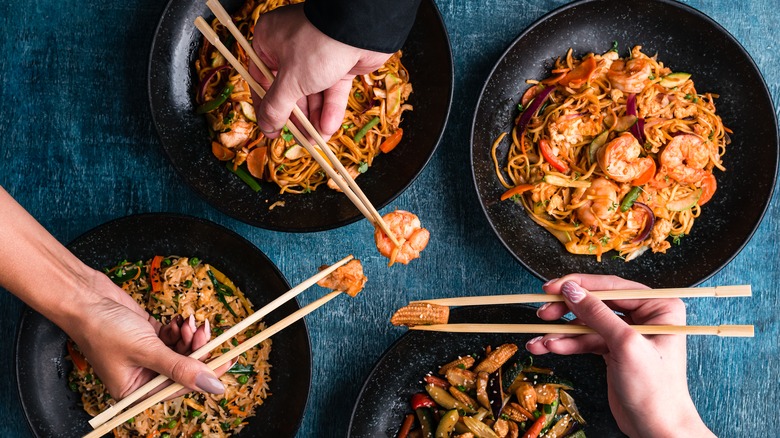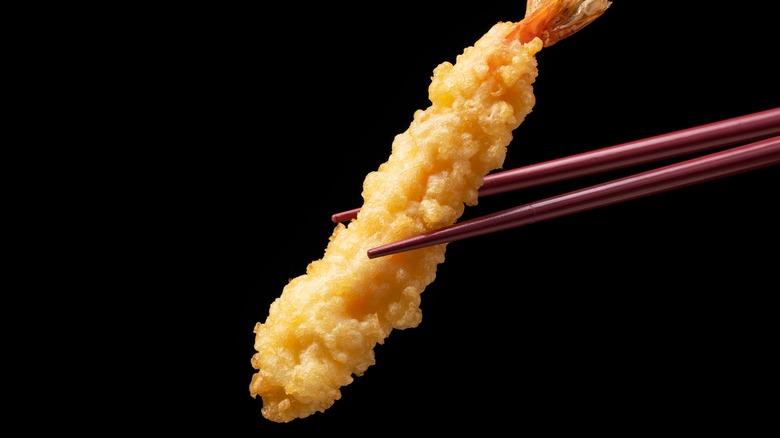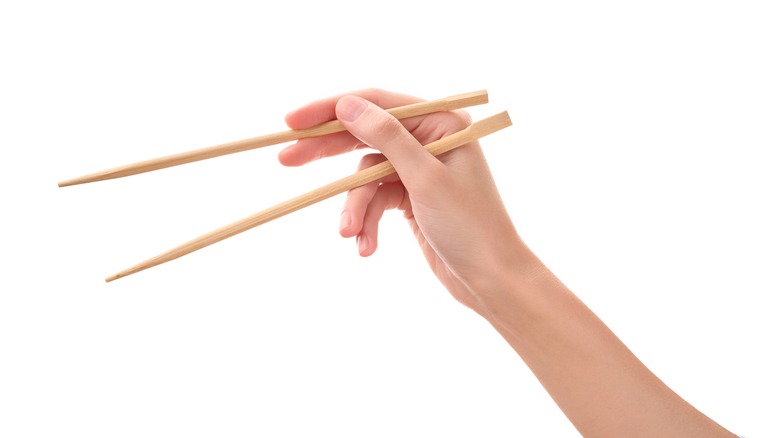The Chopstick Etiquette Mistake That Might Insult Your Host
Eating is an experience that is riddled with social etiquette no matter where you are in the world, and often, it's the usage of cutlery that has the most dos and don'ts. Popping a fork into your mouth is a huge faux pas in Thailand, for example. Bread is practically considered a replacement for knives to help assist food to the fork in France whereas cutlery is altogether ditched for the use of hands in India, the Middle East, Africa, and Mexico. In Brazil and Chile, on the other hand, eating anything without a fork and knife — even pizzas and burgers — is considered a huge social blunder. And since chopsticks take the place of most silverware in Japan and many other parts of Asia, it is this eating utensil that comes with its own little rulebook of etiquette.
One of the biggest mistakes any diner could make when using chopsticks is to rub the two sticks together. Chopsticks have always been seen as more than mere eating vessels throughout history; they were once considered symbols of one's wealth and status and continue to have ceremonial significance even today. In ancient Korea, for example, eating with silver or gold metal chopsticks signified an elite social status whereas cheaper wooden chopsticks were reserved for commoners. Similarly, chopsticks are usually rubbed when they are made of wood, which is why rubbing them can be seen as a sign of disrespect. It implies that you are accusing the host of being cheap by skimping out on good-quality cutlery.
Some chopstick etiquette has to do with ceremonial significance
Chopsticks originated in China, and by 500 AD, they had spread across Japan, Korea, and Vietnam where they were used for more than just regular meals. The Japanese word for chopstick and bridge — hashi — is a homophone, which is why chopsticks were once considered a "bridge" between humans and gods in Japan, enabling humans to share food with deities. During the early days, chopsticks were only used for religious ceremonies wherein upon presenting the sticks to a particular deity as an offering, the said deity would come to possess the sacred chopsticks. The sacred chopsticks were then used to eat all the food that was presented to the deity as an offering, thereby creating the belief that chopsticks were a bridge that helped humans and gods to share a meal together.
While chopsticks have come a long way since, their early religious significance may have set the tone for the many rules that follow when using this eating utensil, especially considering its association with death even today. Most funerals in Vietnam, Japan, China, and Korea will have a bowl of rice with a pair of chopsticks sticking out vertically from it as an offering to the deceased — which is why letting your chopsticks stand upright while eating is considered a distasteful reminder of death. Hashi watashi, or passing food between chopsticks, is another no-no as that evokes memories of passing bones of the deceased between chopsticks at Japanese funerals. Similarly, although rubbing chopsticks together is a less-serious blunder, it's a violation of chopstick etiquette nonetheless.
What it really means when you rub chopsticks together
The reason why rubbing chopsticks is seen as an insult is that diners new to chopsticks generally rub them to get rid of nasty splinters, which are usually a result of breaking open disposable chopsticks (known as waribashi in Japan) made from wood or bamboo. When you rub your chopsticks together — yes, even the disposable ones — what you're really doing is implying that the host has handed you cheap cutlery of inferior quality. Although it's more common to rub chopsticks in China, doing so in Japan is a sign that you're questioning the host's ability to provide fine eating utensils thereby insulting them — which is why it's considered one of the worst mistakes that you could ever make.
Reminding the host of death or accusing them of being cheap aside, there are plenty of other mistakes that could be considered impolite and improper, causing much embarrassment to a chopstick novice. It goes without saying that chopsticks are an eating utensil and shouldn't be played with at the dinner table. It's also considered improper and unhygienic to use chopsticks to pick up food directly from a sharing plate. Chopsticks should be used for food alone and not to move other vessels around whereas leaving them crossed on a plate is very unmannerly, especially in Vietnam — there are chopstick holders for a reason after all. As long as you know the basics of chopstick etiquette, you'll be able to enjoy a delicious meal without insulting anyone.



